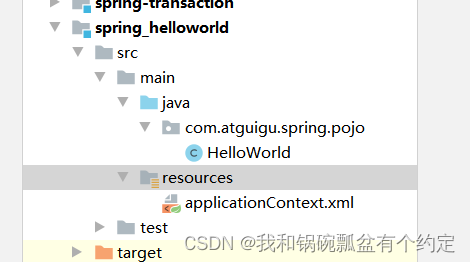一,例子
①创建
Maven Module
②引入依赖
<dependencies>
<!-- 基于Maven依赖传递性,导入spring-context依赖即可导入当前所需所有jar包 -->
<dependency>
<groupId>org.springframework</groupId>
<artifactId>spring-context</artifactId>
<version>5.3.1</version>
</dependency>
<!-- junit测试 -->
<dependency>
<groupId>junit</groupId>
<artifactId>junit</artifactId>
<version>4.12</version>
<scope>test</scope>
</dependency>
</dependencies>
③创建类
HelloWorld
package com.atguigu.spring.pojo;
public class HelloWorld {
public void sayHello(){
System.out.println("hello spring!");
}
}
④创建
Spring
的配置文件

⑤在Spring的配置文件中配置bean
<!--
配置HelloWorld所对应的bean,即将HelloWorld的对象交给Spring的IOC容器管理
通过bean标签配置IOC容器所管理的bean
属性:
id:设置bean的唯一标识
class:设置bean所对应类型的全类名
-->
<bean id="helloworld" class="com.atguigu.spring.bean.HelloWorld"></bean>
配置HelloWorld所对应的bean,即将HelloWorld的对象交给Spring的IOC容器管理
通过bean标签配置IOC容器所管理的bean
属性:
id:设置bean的唯一标识
class:设置bean所对应类型的全类名
⑥创建测试类测试
package com.atguigu.spring.test;
import com.atguigu.spring.pojo.HelloWorld;
import org.junit.Test;
import org.springframework.context.ApplicationContext;
import org.springframework.context.support.ClassPathXmlApplicationContext;
public class HelloWorldTest {
@Test
public void test(){
//获取IOC容器
ApplicationContext ioc=new ClassPathXmlApplicationContext("applicationContext.xml");
//获取ioc容器中的bean
HelloWorld helloworld = (HelloWorld) ioc.getBean("helloworld");
helloworld.sayHello();
}
}
二,获取bean
①方式一:根据
id
获取
由于
id
属性指定了
bean
的唯一标识,所以根据
bean
标签的
id
属性可以精确获取到一个组件对象。
上个实验中我们使用的就是这种方式。
②方式二:根据类型获取
@Test
public void testHelloWorld(){
ApplicationContext ac = new
ClassPathXmlApplicationContext("applicationContext.xml");
HelloWorld bean = ac.getBean(HelloWorld.class);
bean.sayHello();
}
③方式三:根据
id
和类型
@Test
public void testHelloWorld(){
ApplicationContext ac = new
ClassPathXmlApplicationContext("applicationContext.xml");
HelloWorld bean = ac.getBean("helloworld", HelloWorld.class);
bean.sayHello();
}
④注意
当根据类型获取
bean
时,要求
IOC
容器中指定类型的
bean
有且只能有一个
当
IOC
容器中一共配置了两个:
<bean id="helloworldOne" class="com.atguigu.spring.bean.HelloWorld"></bean>
<bean id="helloworldTwo" class="com.atguigu.spring.bean.HelloWorld"></bean>
根据类型获取时会抛出异常:
org.springframework.beans.factory.NoUniqueBeanDefinitionException: No qualifying bean
of type 'com.atguigu.spring.bean.HelloWorld' available: expected single matching bean but
found 2: helloworldOne,helloworldTwo
三,依赖注入之setter注入
①创建学生类
Student
public class Student {
private Integer id;
private String name;
private Integer age;
private String sex;
public Student() {
}
public Integer getId() {
return id;
}
public void setId(Integer id) {
this.id = id;
}
public String getName() {
return name;
}
public void setName(String name) {
this.name = name;
}
public Integer getAge() {
return age;
}
public void setAge(Integer age) {
this.age = age;
}
public String getSex() {
return sex;
}
public void setSex(String sex) {
this.sex = sex;
}
@Override
public String toString() {
return "Student{" +
"id=" + id +
", name='" + name + '\'' +
", age=" + age +
", sex='" + sex + '\'' +
'}';
}
}
②配置
bean
时为属性赋值
<bean id="studentOne" class="com.atguigu.spring.bean.Student">
<!-- property标签:通过组件类的setXxx()方法给组件对象设置属性 -->
<!-- name属性:指定属性名(这个属性名是getXxx()、setXxx()方法定义的,和成员变量无关)
-->
<!-- value属性:指定属性值 -->
<property name="id" value="1001"></property>
<property name="name" value="张三"></property>
<property name="age" value="23"></property>
<property name="sex" value="男"></property>
</bean>
③测试
@Test
public void testDIBySet(){
ApplicationContext ac = new ClassPathXmlApplicationContext("spring-di.xml");
Student studentOne = ac.getBean("studentOne", Student.class);
System.out.println(studentOne);
}





















 169
169











 被折叠的 条评论
为什么被折叠?
被折叠的 条评论
为什么被折叠?








